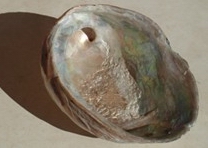 Sales of the world's most expensive seafood — abalone (sea snail, ormer, Haliotis) — increased over Christmas, reported Spanish TV broadcaster RTVE. It attributed the increase to a developing appreciation for the shellfish, traditionally enjoyed by English and French coastal communities, with people paying “astronomical prices” for its flavorsome, delicate meat.
Sales of the world's most expensive seafood — abalone (sea snail, ormer, Haliotis) — increased over Christmas, reported Spanish TV broadcaster RTVE. It attributed the increase to a developing appreciation for the shellfish, traditionally enjoyed by English and French coastal communities, with people paying “astronomical prices” for its flavorsome, delicate meat.On concluding its 18 to 21-month commercial farm trials in western France, southwest England and Jersey, Channel Islands in 2010, the International Abalone Society’s (IAS) project SUDEVAB recorded the best abalone growth in France and best biomass gain per square meter of available habitat was obtained in offshore ORTAC (cylinder) cages.
French abalone production represents some 100 metric tons (MT), largely from fisheries on northern Brittany shores in the northwest. Based in Plouguerneau, France Haliotis is the first abalone farm worldwide to gain organic certification, selling live 6-7 cm sea-bred abalone at EUR 69 (USD 90) per kilogram.
According to Managing Director Sylvain Huchette: “French abalone aquaculture is only kicking off this year, 2013, with 15 MT of product on the market. The industry has taken eight years to establish and now has good prospects for rapid development.”
Farmers are developing new sustainable techniques: the largest farms, France Haliotis and Les Coquillages du Phare, use cages at sea for abalone fed on hand-picked seaweed from local shores. No fishmeal, pharmaceuticals or fertilizers are used.
Production in Jersey, Channel Islands is small at present, but at Jersey Sea Farms in St. Martin, Managing Director Tony Legg explained the lessons learned from other farmed species. “The main development for us has been the completion of trials of the ABBLOX farming system — a cubic meter container, each of which can rear up to 50 kilograms of European abalone in open sea conditions. Linking this with the drive by salmon farmers to attain sustainable integrated multi-trophic aquaculture, this seaweed-eating species has a high wholesale value and is starting to generate serious interest.”
Under the Irish Sea Fisheries Board National Development Plan 2007-13, seaweed farming is itself a significant industry required to produce the 2,000 MT of raw material each year to feed abalone and urchin culture.
The Board’s Marine Research Sub-program supports abalone farmers looking to start seaweed culture to satisfy abalone’s dietary needs. With domestic abalone valued at EUR 56 (USD 73) per kilogram ex-farm, seaweed is a continuous, high quality, daily dietary supply.
Two new Irish farms planned to start production this year should match French volumes by 2016.





